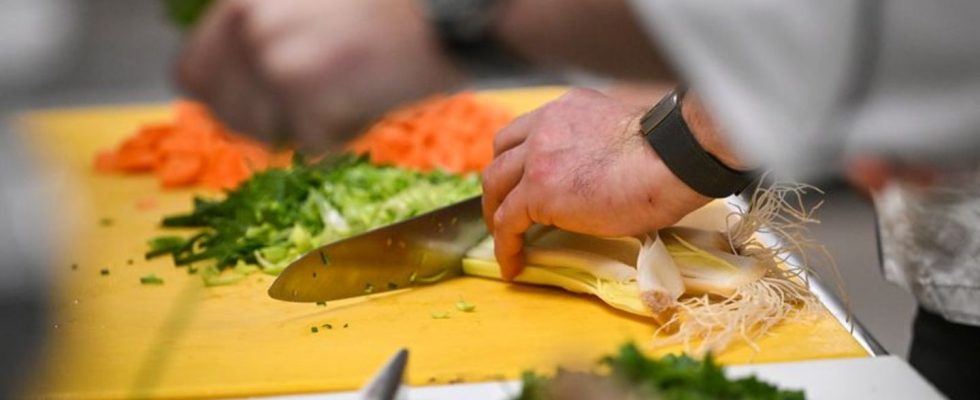Anyone who has earned a Michelin star belongs to the crème de la crème of top gastronomy. There are now more star restaurants in Germany than ever before. Despite the crisis.
Tears, cheers and speechless chefs: the new Michelin stars have been awarded to outstanding restaurants in Hamburg. And although the catering industry is also struggling with a shortage of skilled workers, rising purchasing prices, inflation and higher energy costs, there are more star restaurants in Germany than ever before.
This year, a total of 340 establishments have been awarded at least one star from the “Guide Michelin” gourmet guide. This emerges from the 468-page restaurant guide, which was presented in Hamburg and is due to appear at the beginning of May.
The number of outstanding restaurants also surprised the director of the “Guide Michelin” for Germany and Switzerland, Ralf Flinkenflugel. “We ourselves are amazed at the new record. There have never been so many stars in Germany – especially considering the situation.”
Third star for Edip Sigl: “A dream has come true”
In 2024, ten restaurants will be able to receive the highest Michelin award and receive three stars. New to the star Olympus is Edip Sigl’s Upper Bavarian restaurant “Ess:enz” in Grassau, which was awarded two stars just two years ago and now already has the third star in its pocket. “A really great achievement. What stands out here is the absolute top quality of the products and Mr. Sigl’s very personal style,” said the inspectors.
Sigl was very happy about the award on stage. “Incredible. I thought it couldn’t be any more within three years. I’m really happy,” said the star chef after the award. His children already have blue fingers because they have been keeping their fingers crossed for weeks. “A dream came true.”
The nine other three-star restaurants can be found in Berlin (“Rutz”), Baden-Württemberg (“Bareiss” and “Schwarzwaldstube” in Baiersbronn), Bavaria (“Jan” in Munich), Hamburg (“The Table”), Lower Saxony (“Aqua” in Wolfsburg), Rhineland-Palatinate (“Waldhotel Sonnora” in Dreis, “Schanz. Restaurant” in Piesport) and in Saarland (“Victor’s Fine Dining by Christian Bau” in Perl).
The inspection team also rated 50 restaurants with two stars. Three of these are new: the “Komu” in Munich, the “Pur” in Berchtesgaden (Bavaria) and the “Seo Küchenhandwerk” in Langenargen (Baden-Württemberg). In addition, 280 top kitchens with one star – 32 of which are new – are now in the “Guide Michelin Germany 2024”.
The Sommelier Award also goes to the “Schwarzwaldstube”. Sommelier Stéphane Gass, who has been working for 30 years, was able to take it home with him. “This is a special and crazy moment. This is very special,” he said on stage. The Mentor Chef Award went to Sven Elverfeld from the three-star restaurant “Aqua” in Wolfsburg. His tip for chefs: “Be open to new things. Also let yourself be inspired. And: No matter where you work, you almost never work alone. There always has to be a team, otherwise it won’t work from start to finish.” The Young Chef Award went to Cédric Staudenmayer, who also won his first star for the restaurant “Cédric” in Weinstadt (Baden-Württemberg) in his mid-20s.
Top kitchens are more relaxed than before – but with increased quality
In Germany, around two dozen testers work anonymously. The awarding of the coveted stars is based on a uniform rating system – regardless of the country. The criteria include the quality of the products, a personal touch, the price-performance ratio and consistent quality over the long term.
Ten years ago there were only 274 restaurants with one, two or three stars in Germany, said Flinkenflugel. Since then, the German culinary elite has moved a lot. Things are looser, more casual and more fun in the top restaurants. “It’s not as stiff as it was 20, 30 years ago.” At the same time the quality has increased. “The criteria haven’t changed – German cuisine is getting better and better,” said Flinkenflugel. “We could also show a little more pride to the outside world about what has developed here over the past 10 to 15 years.”
Sustainability awarded green stars
There are also noticeable changes in terms of sustainability. More and more kitchens are taking up customers’ wishes for environmentally conscious behavior. They cook seasonally, regionally, use meat and fish from species-appropriate husbandry and avoid waste. 77 restaurants can now call a Green Star their own – ten more than in 2023.
The Association of German Chefs (VdK) also considers this development to be important. Many kitchens would strive for the top level, but there is also enormous pressure to keep a star, said VdK President Daniel Schade to the dpa. “I find the “Green Stars” exciting, as they have their finger on the pulse with their focus on sustainability.” However, there is very good culinary quality in Germany with and without a star.
However, some restaurants also lost a star. 27 kitchens had to give one or more stars. The reasons for this are different: “They either closed or changed their concept or there are quality reasons,” said Flinkenflugel.
The little red travel guide “Guide Michelin” was intended to encourage more drivers to travel more than 100 years ago. The founders of the French tire company Michelin wanted to use this to boost their sales. The travel guide, first published in 1910, initially contained maps and tips for drivers on refueling, changing tires, eating and staying overnight. The first stars for fine dining were finally awarded in 1926. The first Michelin stars were awarded in Germany in 1966.
In addition to the “Michelin Guide”, the “Gault&Millau” restaurant guide also appears regularly as an important international gourmet guide. He awards chef’s hats for excellent culinary skills.

